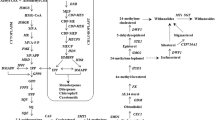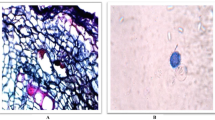Abstract
Fungal endophytes inhabit living tissues of plants without any apparent symptoms and in many cases are known to produce secondary metabolites similar to those produced by their respective host plants. However on sub-culture, the endophytic fungi gradually attenuate their ability to produce the metabolites. Attenuation has been a major constraint in realizing the potential of endophytic fungi as an alternative source of plant secondary metabolites. In this study, we report attempts to restore camptothecine (CPT) production in attenuated endophytic fungi isolated from CPT producing plants, Nothapodytes nimmoniana and Miquelia dentata when they are passed through their host plant or plants that produce CPT and when treated with a DNA methyl transferase inhibitor. Attenuated endophytic fungi that traversed through their host tissue or plants capable of synthesizing CPT, produced significantly higher CPT compared to the attenuated fungi. Attenuated fungus cultured in the presence of 5-azacytidine, a DNA methyltransferase inhibitor, had an enhanced CPT content compared to untreated attenuated fungus. These results indicate that the attenuation of CPT production in endophytic fungi could in principle be reversed by eliciting some signals from plant tissue, most likely that which prevents the methylation or silencing of the genes responsible for CPT biosynthesis.







Similar content being viewed by others
References
Arx VJA (1981) The genera of fungi sporulating in pure culture. A. R. Gartner Verlag kommanditgesellschaft, FL-9490 Vaduz, Germany
Azevedo JL, Macchroni W, Pereira JO, Araujo WL (2000) Endophytic microorganisms: a review on insect control and recent advances on tropical plants. Biotechnology 3:40–65
Beau J, Mahid N, Burda WN, Harrington L, Shaw LN, Mutka T, Kyle DE, Barisic B, van Olphen Alberto, Baker BJ (2012) Epigenetic tailoring for the production of anti-infective cytosporones from the marine fungus Leucostoma persoonii. Marine Drugs 4:762–774
Berg G, Krechel A, Faltin F, Ulrich A, Hallmann J, Grosch R (2004) Endophytes: a new source for environmental biotechnology. In: Abstracts of 10th international symposium on microbial ecology ISME-10, “Microbial Planet: sub surface to space”, Cancun, Mexico, August 22–27
Chen H-J, Awakawa T, Sun J-Y, Wakimoto T, Abe I (2013) Epigenetic modifier-induced biosynthesis of novel fusaric acid derivatives in endophytic fungi from Datura stramonium L. Nat Prod Bioprospecting 3:20–23
Chujo T, Scott B (2014) Histone H3K9 and H3K27 methylation regulates fungal alkaloid biosynthesis in a fungal endophyte–plant symbiosis. Mol Microbiol 2:413–434
Devari S, Jaglan S, Kumar M, Deshidi R, Guru S, Bhushan S, Kushwaha M, Gupta AP, Gandhi SG, Sharma JP, Taneja SC, Vishwakarma RA, Shah BA (2014) Capsaicin production by Alternaria alternata, an endophytic fungus from Capsicum annum; LC–ESI–MS/MS analysis. Phytochemistry 98:183–189
Dhingra OD, Sinclair JB (1993) Basic plant pathology methods. CRC Press, Boca Raton
El-Elimat T, Raja HA, Graf TN, Faeth SH, Cech NB, Oberlies NH (2014) Flavonolignans from Aspergillus iizukae, a fungal endophyte of milk thistle (Silybum marianum). J Nat Prod 77:193–199
Ezra D, Skovorodnikova J, Kroitorkeren T, Denisov Y, Liarzi O (2010) Development of methods for detection and Agrobacterium-mediated transformation of the sterile, endophytic fungus Muscodor albus. Biocontrol Sci Tech 20:83–97
Fisch KM, Gillaspy AF, Gipson M, Henrikson JC, Hoover AR, Jackson L, Najar FZ, Wägele H, Cichewicz RH (2009) Chemical induction of silent biosynthetic pathway transcription in Aspergillus niger. J Ind Microbiol Biotechnol 36:1199–1213
Gurudatt PS, Priti V, Shweta S, Ramesha BT, Ravikanth G, Vasudeva R, Amna T, Deepika S, Ganeshaiah KN, Uma Shaanker R, Puri S, Qazi N (2010) Attenuation of camptothecin production and negative relation between hyphal biomass and camptothecin content in endophytic fungal strains isolated from Nothapodytes nimmoniana Grahm (Icacinaceae). Curr Sci 98:1006–1009
Henrikson JC, Hoover AR, Joyner PM, Cichewicz RH (2009) A chemical epigenetics approach for engineering the in situ biosynthesis of a cryptic natural product from Aspergillus niger. Org Biomol Chem 7:435–438
Kumara PM, Soujanya KN, Ravikanth G, Vasudeva R, Ganeshaiah KN, Shaanker RU (2014) Rohitukine, a chromone alkaloid and a precursor of flavopiridol, is produced by endophytic fungi isolated from Dysoxylum binectariferum Hook.f and Amoora rohituka (Roxb). Wight & Arn. Phytomedicine 21:541–546
Kusari S, Lamshöft M, Zühlke S, Spiteller M (2008) An endophytic fungus from Hypericum perforatum that produces hypericin. J Nat Prod 71:159–162
Kusari S, Zühlke S, Spiteller M (2009) An endophytic fungus from Camptotheca acuminata that produces camptothecin and analogues. J Nat Prod 72:2–7
Kusari S, Zuelke S, Spiteller M (2011) Effect of artificial reconstitution of the interaction between the plant Camptotheca acuminata and the fungal endophyte Fusarium solani on camptothecin biosynthesis. J Nat Prod 74:764–775
Li J, Sidhu RS, Ford EJ, Long DM, Hess WM, Strobel GA (1998) The induction of taxol production in the endophytic fungus-Periconia sp. from Torreya grandifolia. J Ind Microbiol Biotechnol 20:259–264
Li JY, Strobel GA, Harper JK, Lobkovsky E, Clardy J (2000) Cryptocin, a potent tetramic acid antimycotic from the endophytic fungus Cryptosporiopsis cf. quercina. Org Lett 2:767–770
Michielse CB, Hooykaas PJ, van den Hondel CA, Ram AF (2008) Agrobacterium-mediated transformation of the filamentous fungus Aspergillus awamori. Nat Protoc 3:1671–1678
Mohana Kumara P, Zuehlke S, Priti V, Ramesha BT, Shweta S, Ravikanth G, Vasudeva R, Santhoshkumar TR, Spiteller M, Uma Shaanker R (2011) Fusarium proliferatum, an endophytic fungus from Dysoxylum binectariferum Hook.f, produces rohitukine, a chromane alkaloid possessing anti-cancer activity. Antonie Van Leeuwenhoek 101:323–329
Murashige T, Skoog F (1962) A revised medium for rapid growth and bioassays with tobacco tissue cultures. Physiol Plant 15:473–497
Murray FR, Latch GCM, Scott DB (1992) Surrogate transformation of perennial ryegrass, Lolium perenne, using genetically modified Acremonium endophyte. Mol Gen Genet 233:1–9
Priti V, Ramesha BT, Shweta S, Ravikanth G, Ganeshaiah KN, Suryanarayanan TS, Uma Shaanker R (2009) How promising are endophytic fungi as alternative sources of plant secondary metabolites. Curr Sci 97:4–6
Rahman MH, Saiga S (2005) Endophytic fungi (Neotyphodium coenophialum) affect the growth and mineral uptake, transport and efficiency ratios in tall fescue (Festuca arundinacea). Plant Soil 272:163–171
Ramesha BT, Amna T, Ravikanth G, Gunaga RP, Vasudeva R, Ganeshaiah KN, Uma Shaanker R, Khajuria RK, Puri SC, Qazi GN (2008) Prospecting for camptothecines from Nothapodytes nimmoniana in the Western Ghats, South India: identification of high yielding sources of camptothecin and new families of camptothecines. J Chromatogr Sci 46:362–368
Ramesha BT, Suma HK, Senthilkumar U, Priti V, Ravikanth G, Vasudeva R, Santhosh Kumar TR, Ganeshaiah KN, Uma Shaanker R (2013) New plant sources of the anti-cancer alkaloid, camptothecine from the Icacinaceae taxa, India. Phytomedicine 20:521–527
Sachin N, Manjunatha BL, Mohana Kumara P, Ravikanth G, Shweta S, Suryanarayanan TS, Ganeshaiah KN, Uma Shaanker R (2013) Do endophytic fungi possess pathway genes for plant secondary metabolites? Curr Sci 104:178–182
Shwab EK, Bok JW, Tribus M, Galehr J, Graessle S, Keller NP (2007) Histone deacetylase activity regulates chemical diversity in Aspergillus. Eukaryot Cell 6:1656–1664
Shweta S, Zuehlke S, Ramesha BT, Priti V, Mohana Kumar P, Ravikanth G, Spiteller M, Vasudeva R, Shaanker RU (2010) Endophytic fungal strains of Fusarium solani, from Apodytes dimidiata E. Mey. ex Arn (Icacinaceae) produce camptothecin, 10-hydroxycamptothecin and 9-methoxycamptothecin. Phytochemistry 71:117–122
Shweta S, Gurumurthy BR, Ravikanth G, Ramanan US, Shivanna MB (2013) Endophytic fungi from Miquelia dentata Bedd produce the anti-cancer alkaloid, camptothecine. Phytomedicine 20:337–342
Stierle A, Strobel G (1995) The search of taxo roducing microorganism among the endophytic fungi of the pacific yew, Taxus brevifolia. J Nat Prod 58:1315–1324
Stierle A, Strobel G, Stierle D (1993) Taxol and taxane production by Taxomyces andreanae, an endophytic fungus of Pacific yew. Science 260:214–216
Strobel GA (2002) Rain forest endophytes and bioactive products. Crit Rev Biotechnol 22:325–333
Tafur S, Nelson JD, DeLong DC, Svoboda GH (1976) Antiviral components of Ophiorrhiza mungos. Isolation of camptothecin and 10-methoxycamptothecin. Lloydia 39:261–262
Vainio EJ, Korhonen K, Hantula J (1998) Genetic variation in Phlebiopsis gigantea as detected with random amplified microsatellite (RAMS) markers. Mycol Res 102:187–192
Wang J, Li G, Lu H, Zheng Z, Huang Y, Su W (2000) Taxol from Tubercularia sp. strain TF5, and endophytic fungi of Taxus mairei. FEMS Microbiol Lett 193:249–253
Wang F, Xu M, Li Q, Sattler I, Lin W (2010) P-aminoacetophenonic acids produced by a mangrove endophyte Streptomyces sp. (strain HK10552). Molecules 15:2782–2790
Williams RB, Henrikson JC, Hoover AR, Lee AE, Cichewicz RH (2008) Epigenetic remodeling of the fungal secondary metabolome. Org Biomol Chem 6:1895–1897
Xiang PU, Li G, Xiao Q, Yi J, Tian Y, Zhang G, Zhao L, Luo Y (2013) Isolation, attenuation, and secondary metabolites of attenuated camptothecin-producing endophytic fungus Aspergillus sp. LY013 from Camptotheca acuminata. Chin J Appl Environ Biol 5:787–793
Yang X, Zhang L, Guo B, Guo S (2004) Preliminary study of a vincristine producing endophytic fungus isolated from leaves of Catharanthus roseus. Chin Tradit Herbal Drugs 35:79–81
Zhou L, Cao X, Yang C, Wu X, Zhang L (2004) Endophytic fungi of Paris polyphylla var. yunnanensis and steroid analysis in the fungi. Nat Prod Res Dev 16:198–200
Acknowledgments
The work was supported by grants from the Department of Biotechnology, Government of India. Sagar Jadhav gratefully acknowledges the ICAR, New Delhi, for providing JRF. Authors acknowledge Dr. T Pradeep, IIT Madras for ESI–MS/MS analysis, Dr. David Ezra, Department of Plant Pathology and Weed Research, ARO, Israel for EHA105 Agrobacterium strain (with EGFP gene) and Senthil Kumar U for assistance in sample collection.
Author information
Authors and Affiliations
Corresponding author
Electronic supplementary material
Below is the link to the electronic supplementary material.
Rights and permissions
About this article
Cite this article
Vasanthakumari, M.M., Jadhav, S.S., Sachin, N. et al. Restoration of camptothecine production in attenuated endophytic fungus on re-inoculation into host plant and treatment with DNA methyltransferase inhibitor. World J Microbiol Biotechnol 31, 1629–1639 (2015). https://doi.org/10.1007/s11274-015-1916-0
Received:
Accepted:
Published:
Issue Date:
DOI: https://doi.org/10.1007/s11274-015-1916-0




